
3 Reasons Why Goal Setting DOESN’T WORK For Losing Weight (And What To Do About It)
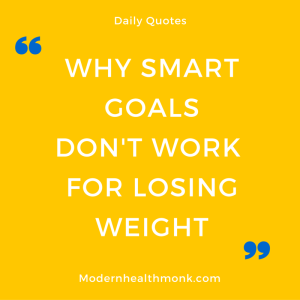 You’ve heard the ultimate lie of goal setting before: Just set SMART goals, and eventually, you’ll get there.
You’ve heard the ultimate lie of goal setting before: Just set SMART goals, and eventually, you’ll get there.
Except it doesn’t usually work.
And with weight loss, it almost never works.
In fact, the entire idea of SMART goals largely is garbage when it comes to weight loss – and there’s a much better way.
#1 Smart Goals, Unfortunately, Don’t Work All The Time
The idea of setting “SMART” goals originated with a 1981 issue of a business management paper.
The author talked about….
S – Specific
M – Measurable
A – Actionable
R – Realistic
T – Timely (or time-bound)
So here’s why they don’t work at the bottom line: R and T (realistic and time-bound) we often can’t control.
Consider this: let’s say you’re 300 pounds overweight, you don’t know the difference between a green bean and a wheat bread, and you really want to lose weight desperately.
So you set a SMART goal:
I want to lose 100 pounds, by changing what I eat, in the next 6 months!
It fulfills all the parts of the SMART idea, right?
It’s specific – I want to lose 100 pounds.
It’s measurable – we can measure weight loss.
It’s actionable – we’re changing just food.
But now we come to R & T – how do you know what’s realistic if you don’t even know how to get to the goal?
How do you know you can reach it in the time you allotted yourself?
You DON’T.
So realistically what ends up happening is that we begin by starting off all excited and energized, and then when we hit the first roadblock (Uhh… what do I even eat for breakfast?), we get stuck.
Do I eat carbs? Protein? Fats? None of the above? Plants? Should I just fast and not eat at all?
Realistically, most people get stuck here almost their entire lives! It’s insane.
So if you have no idea what you should be doing, and you don’t have a clue how to get there, how are you supposed to even remotely be able to control how long it takes you to achieve your goal?
Hint: you can’t.
2. Almost Nobody Can Control How Long it Takes to Reach a Goal (The Illusion of Control)
Consider this, especially when it comes to the timeline of trying to reach our goals.
If you want to lose weight and don’t know what to eat, how fast can you lose weight?
If you want a better marriage, but you don’t know the strategies to implement or the things that need changing, how do you actually change anything, let alone do it in 30 days?
If you want to build a business but don’t have a clue how to actually build a business, how can you plan on earning an extra $500 a month in the next 6 months?
The reality – It just doesn’t work – at all, unfortunately.
For example, about a decade ago I started working out because I wanted to gain weight, with the advice from Jack Lalanne in my head: Exercise is the great equalizer.
If you’re thin, it’ll help bulk you up. If you’re fat, it’ll help slim you down.
Fast forward about a decade, I’m now about 40 pounds heavier than my natural bodyweight, and look much closer to the celebrity “fit” look that I wanted.
So why did it take me a decade?
Realistically, most of that growth happened in maybe 3 years of my exercising, but it took me ten years to get to where I am.
Here’s why:
Year 1-3: don’t have a damn clue what I’m doing, waste a lot of time not doing the right stuff in the gym, and didn’t realize that almost 100% of my results would come from eating right.
Year 2-5: actually start seeing beginner results, which flatten out and plateau very quickly.
Year 5-6: same old plateau. No different results even though I’m still training 4x a week and working out hard.
Year 6-8: I finally figure out one of the vital few habits: how much I eat per day, and what I’m eating. I track this, and gain 15 pounds in one year. More than I had in the past five years.
Year 8-10: More consistency. I finally realized that the secret is really a consistency game, and is about tiny habits. I track those same few food habits, allow myself to be flexible, don’t beat myself up when I get off track, and then I get around five pounds closer to my goal each year.
Look at what accounted for half of my wasted time:
– I didn’t know what to do
– I couldn’t stay consistent, juggling multiple jobs, working, life, etc.
Here’s the thing though, when I began, I assumed that it was just going to be a straightforward, straight line. Just plug along and see the results I wanted.
3. The Road Is Never Straight
A few weeks back, I wrote an article on why you should keep trying to lose weight and “diet,” even if you’ve failed 20x before.
I shared this little drawing, of how losing weight really goes – which is the typical lifecycle for any person trying to achieve their goals:
We tend to think it’s just a simple straight line: get the perfect plan, start, see results, keep seeing results (“2 pounds a week until I get there”), and then we arrive.
Unfortunately, almost nothing in this assumption is true.
Yes, it sucks.
And yes, it’s hard as hell.
Realistically, the first roadblock hits us when we don’t even know which diet plan to follow.
Then it hits us the first time we over-restrict ourselves, and binge.
And then the third time it usually hits us is when Friday hits, and it’s a special occasion, so we go out, have a couple margaritas, get off track, and then wake up bloated and guilty the next day wondering if we should even keep on trying.
The Solution: Set Process Goals.
Great.
So are we out of luck?
If the normal way of setting goals doesn’t work, what am I supposed to do?
Here’s the big thing: set process goals.
Since we know that we can’t control how fast we reach the outcome, and we don’t even know what’s “realistic” the only way to truly reach our goals without hating our lives is to set DAILY goals.
This is the entire reason my book is called Master The Day – because if you just make each day count, you’re not only not worried about the future and how far you are on the progress bar, but you’ll also reach your goal anyway.
You’ll get there with 1/100th of the stress, headache, and heartache.
Step #1: The Morning Routine & Written Focus
I’ve tried a HUGE variety of different methods for trying to ingrain certain key behaviors and habits (like regular meditation to off-set working lots of hours), and by far, and I mean by far, nothing has worked as well as doing things first thing in the morning.
Now some of you might be groaning going, “Ugh, I have to get up earlier? C’mon Alex…”
Think about it: it makes logical sense.
After work? Too tired.
Late at night? Definitely not happening.
Middle of the day? Busy.
Morning… jackpot.
I don’t get up at 5 am. In fact, I don’t even really get up that early. I get up an hour earlier than normal, which means around 6:45/7 am before going to work at 9 am. Doable, right?
And here’s the first step in changing ANY habit.
I write down what’s not working, and what outcome I want.
Example:
“Problem: I’m stressed to the point of nervous breakdowns 3/7 days a week. What I want is to meditate 20 minutes a day to have that calm.”
“Problem: I feel and look crappy. I want to lose ten more pounds.”
And then I put this on paper. And I review that paper first thing in the morning. What’s the goal? What’s the burning desire? What do you really want?
Along with the first step of writing down what you want, the second step is to write down what potential daily habits can get you there.
Here’s what that looks like:

So it’s great that we want some magical outcome – but it starts to become a reality when we actually put pen to paper to think about what daily, tiny actions need to happen over the days, weeks, months and years to make that a reality.
Step #2: The Daily Checkin
The next step is the daily check-in.
Hands down, there is nothing more effective for getting healthy or improving your life than some kind of daily accountability. And the daily check-in is a way to do that without relying on other people or external programs.
So here’s what it looks like.
In step #1 you figured out your target goal, e.g. lose 10 pounds, including the potential daily habits that will get you there.
Now each week you list a few simple habits – these shouldn’t be stretch goals, they should be easy. So easy it almost seems pointless. And here’s what you do with these few habits.
You whip out a piece of white paper when you get to your office on Monday morning (or wherever you spend most of your time during the week).
And you create a few columns for the days of the week, and on the left you list your few tiny habits like this:

And then you track the daily habit as your day goes along. “Did I do those 10 minutes? Did I eat this thing? Did I avoid that thing?”
You just put a check mark if you did the habit, and you don’t put anything if you didn’t.
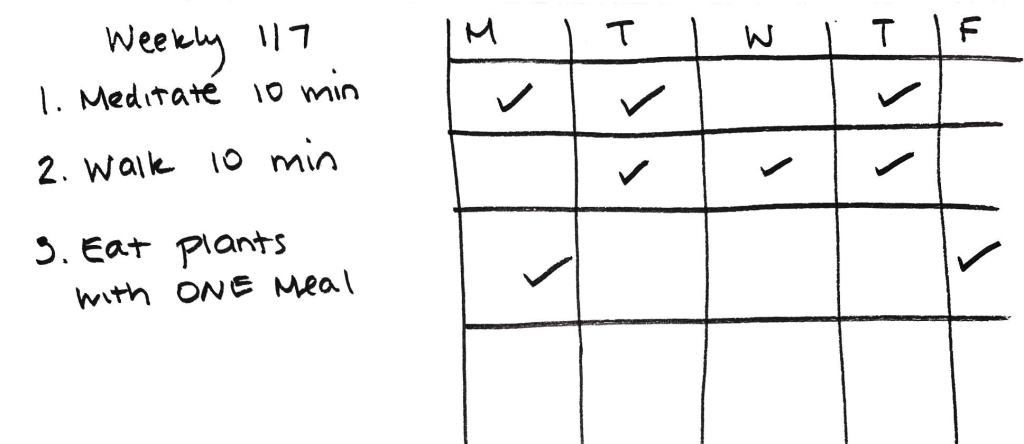 You leave this at your desk (or wherever you spend 40 hours a week 9-5) so you have 24/7 feedback, and you’re constantly reminded throughout the day about what new habits you are working on ingraining into your life.
You leave this at your desk (or wherever you spend 40 hours a week 9-5) so you have 24/7 feedback, and you’re constantly reminded throughout the day about what new habits you are working on ingraining into your life.
Step #3: The Weekly Progress Review
The third step of this process is you need to review what worked. And what didn’t.
So you tally up the scores of those check marks or those lack of check marks. What worked? What didn’t? How many times a week did you do all the stuff you said you were going to do?
Let’s say we use the following scores just for this example:
- Meditation: 3/5: 60%
- Walk 10 minutes a day: 3/5: 60%
- Eat plants with one meal: 2/5: 40%
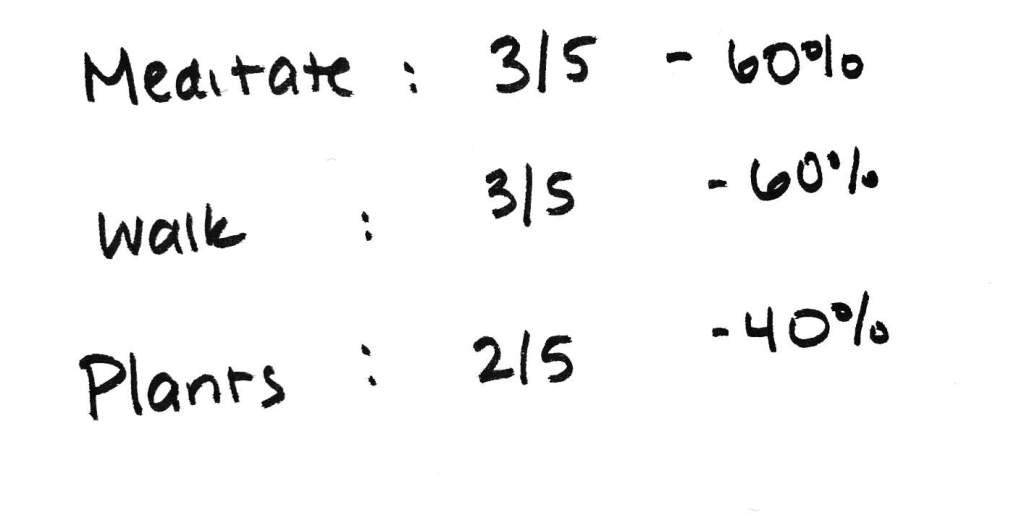 So now you know – in real time – how often you’re doing these habits, and what’s not working.
So now you know – in real time – how often you’re doing these habits, and what’s not working.
Then, list what why things didn’t work.
So if you said you only ate plants 2/5 days… why was that?
Do you hate plants?
Do you not know how to cook them?
Do they just freak you out?
You need to know why something didn’t work in order to cultivate a NEW habit that’ll help things work for you. This entire reflection process is absolutely critical to making things work. Because if things don’t go well, and you didn’t re-evaluate to know why they didn’t go well, nothing will change next week.
Finally, you use these insights to figure out the habits for next week.
Step #4: What New Habits Need to Happen This Week
Okay… now what’s important is not what’s going wrong, or what’s going right, but WHY things aren’t working. E.g. if we say “I didn’t meditate 5x a week like I said I would,” that’s fine.
But what new habits do you need to create to actually do that?
That’s what goes on the sheet this week.
So let’s take a look at last week’s habits.
Meditation. I only did it 60% of the time because I realized i’m usually too tired at the end of the day.
Potential new habit: Do it the first 10 minutes of my lunch break.
Walking. I only did it 60% of the time because I usually go during the evening but now it’s winter, and it’s freezing so I don’t really want to go outside.
Potential new habit: Do it in the morning when it’s a bit warmer, or try it immediately after work.
Eating plants. I only did it 40% of the time because I don’t know how to cook plants and I hate the taste.
Potential new habit: Put the plants in a smoothie with honey and lots of fruits, so it tastes sweet but you’re still eating plants. Plus, with the smoothie it’ll take you less than five minutes a day, and no cooking is required.
Makes sense?
By building in the habit of reflection, we figure out what habits just aren’t working – why – and then what new habits we need to implement that actually work for us.
What potential new habits you want to cultivate:

And then finally, those become your habits for next week:
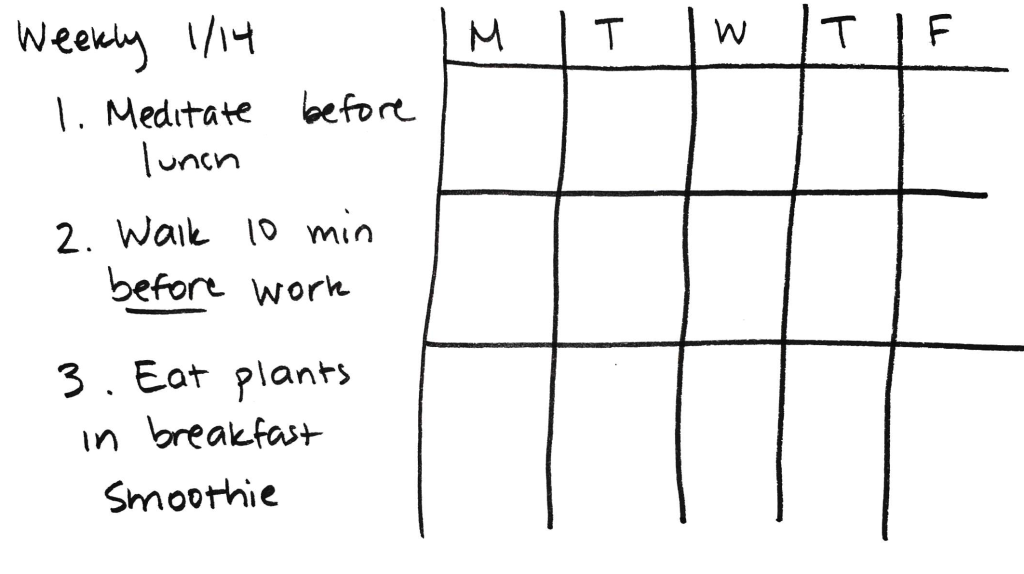 That’s a quick rundown on how to set proper “process goals” to really be successful at losing weight, without hating yourself, without constant scale checking.
That’s a quick rundown on how to set proper “process goals” to really be successful at losing weight, without hating yourself, without constant scale checking.
Your Tiny Habit For Today

The promise of goal setting makes sense: if you have a goal in your head, you’re more likely to be ambitious and reach it.
And this is where I agree.
But I’ve personally never found SMART goals to work (with my students or in my own life) for weight loss – ever.
The best way I’ve found?
Process goals.
Find the core daily habits.
Track days, not pounds.
Then persist, and be patient.
Thoughts?
-Alex
Have You Read My New Book Yet?
Read more about this in my book Master The Day. You’ll learn the nine daily success habits I learned interviewing people that lost 100+ pounds and kept it off in a healthy way – by changing their habits. Plus, you’ll get a free $100 video course if you show me your receipt.
Images: Used with permission from freedigitalphotos.net

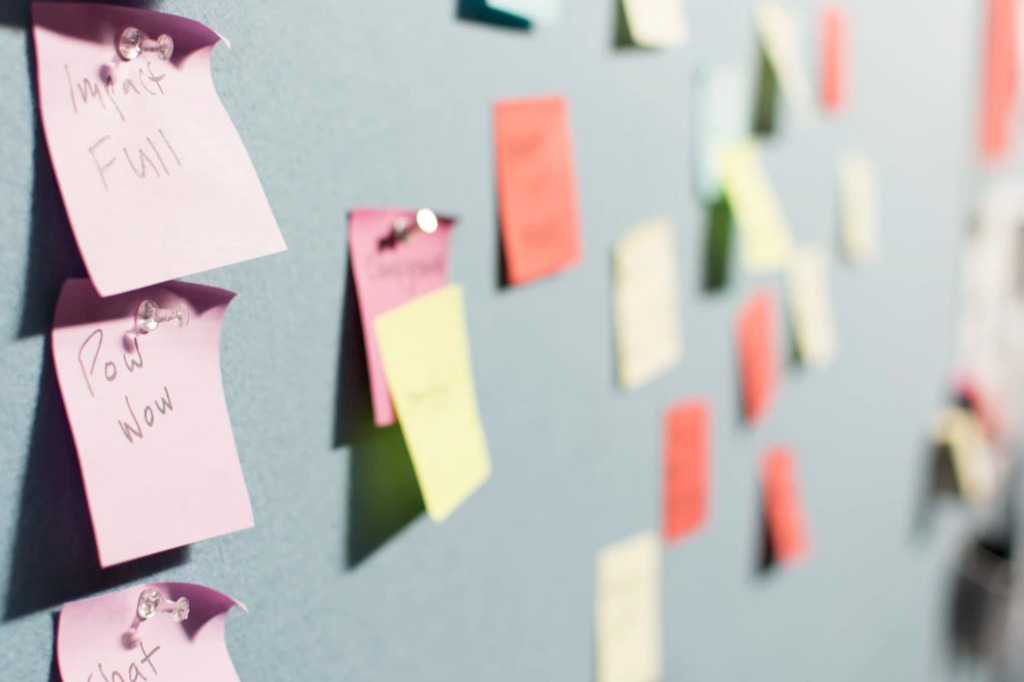



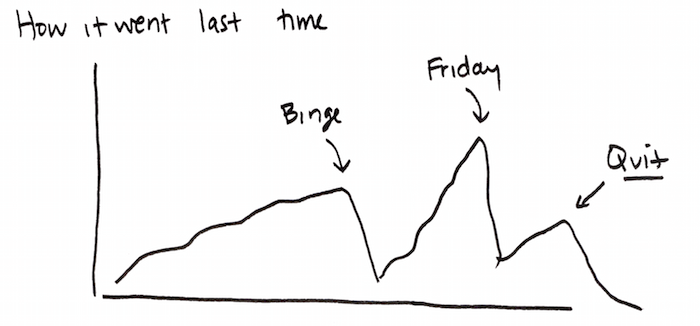



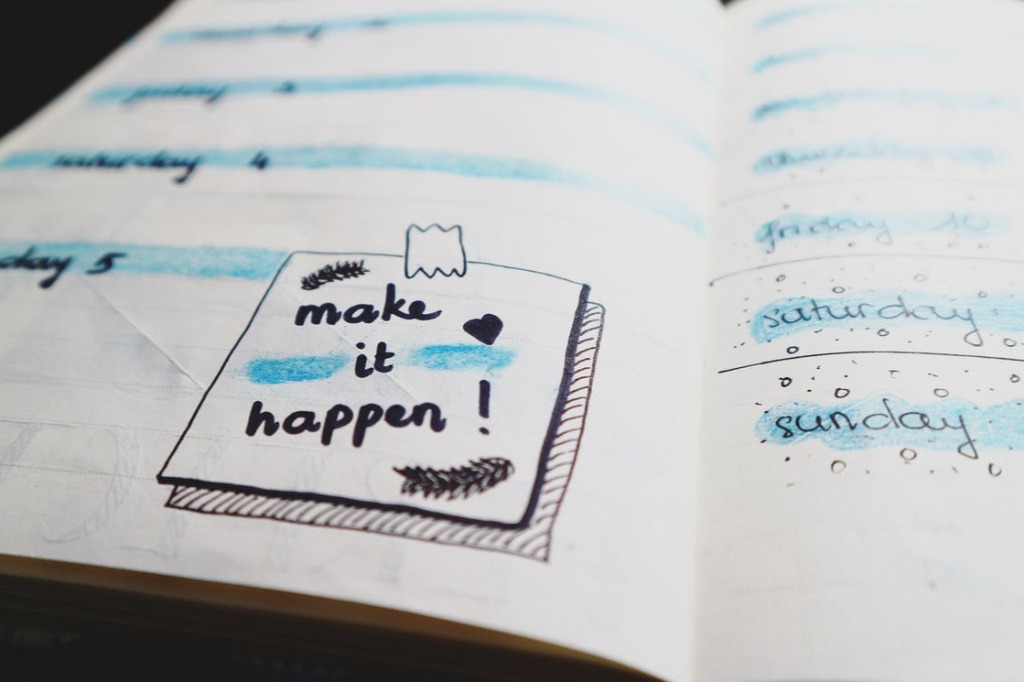


I sounds so simple! And I still mess it up 🙂 What I find hard is identifying the tiny habits. My tiny habits for the week are 1-Drink a bottle of water before starting my day or breakfast. 2-Walk 15 minutes/day 3-avoid chocolate. Once these are mastered, do we enhance them? like walk 30 min/day or no sugar? or do we try sticking to them 1 more week until we don’t need the tracking sheet to do them? Or can we create tiny habit that will eventually help with a bigger one? For example getting more sleep… no more ipad 30 minutes before sleeping, be in bed by 10… ? Just thinking out loud 🙂
Hey Mouna,
Personally, I stick with these things until you don’t need to really track them anymore. You could work your way up to the 40 min/4x a week in the gym goal (for example), and then move onto another one while making sure you still stick with it.
And yes! Enhance them too, or add a second tiny habit.